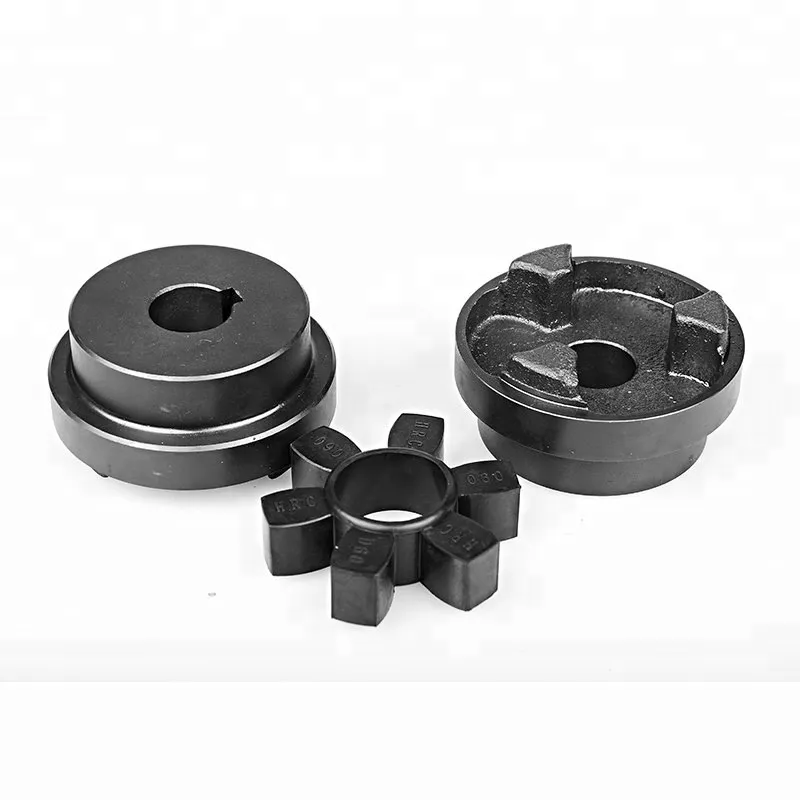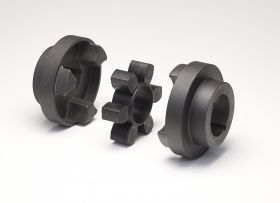Product Description
Flexible flex Fluid Chain Jaw flange Gear Rigid Spacer PIN HRC MH NM universal Fenaflex Oldham spline clamp tyre grid hydraulic servo motor shaft Coupling
Product Description
The function of Shaft coupling:
1. Shafts for connecting separately manufactured units such as motors and generators.
2. If any axis is misaligned.
3. Provides mechanical flexibility.
4. Absorb the transmission of impact load.
5. Prevent overload
We can provide the following couplings.
| Rigid coupling | Flange coupling | Oldham coupling |
| Sleeve or muff coupling | Gear coupling | Bellow coupling |
| Split muff coupling | Flexible coupling | Fluid coupling |
| Clamp or split-muff or compression coupling | Universal coupling | Variable speed coupling |
| Bushed pin-type coupling | Diaphragm coupling | Constant speed coupling |
Company Profile
We are an industrial company specializing in the production of couplings. It has 3 branches: steel casting, forging, and heat treatment. Main products: cross shaft universal coupling, drum gear coupling, non-metallic elastic element coupling, rigid coupling, etc.
The company mainly produces the industry standard JB3241-91 swap JB5513-91 swc. JB3242-93 swz series universal coupling with spider type. It can also design and produce various non-standard universal couplings, other couplings, and mechanical products for users according to special requirements. Currently, the products are mainly sold to major steel companies at home and abroad, the metallurgical steel rolling industry, and leading engine manufacturers, with an annual production capacity of more than 7000 sets.
The company’s quality policy is “quality for survival, variety for development.” In August 2000, the national quality system certification authority audited that its quality assurance system met the requirements of GB/T19002-1994 IDT ISO9002:1994 and obtained the quality system certification certificate with the registration number 0900B5711. It is the first enterprise in the coupling production industry in HangZhou City that passed the ISO9002 quality and constitution certification.
The company pursues the business purpose of “reliable quality, the supremacy of reputation, commitment to business and customer satisfaction” and welcomes customers at home and abroad to choose our products.
At the same time, the company has established long-term cooperative relations with many enterprises and warmly welcomes friends from all walks of life to visit, investigate and negotiate business!
How to use the coupling safely
The coupling is an intermediate connecting part of each motion mechanism, which directly impacts the regular operation of each motion mechanism. Therefore, attention must be paid to:
1. The coupling is not allowed to have more than the specified axis deflection and radial displacement so as not to affect its transmission performance.
2. The bolts of the LINS coupling shall not be loose or damaged.
3. Gear coupling and cross slide coupling shall be lubricated regularly, and lubricating grease shall be added every 2-3 months to avoid severe wear of gear teeth and serious consequences.
4. The tooth width contact length of gear coupling shall not be less than 70%; Its axial displacement shall not be more significant than 5mm
5. The coupling is not allowed to have cracks. If there are cracks, it needs to be replaced (they can be knocked with a small hammer and judged according to the sound).
6. The keys of LINS coupling shall be closely matched and shall not be loosened.
7. The tooth thickness of the gear coupling is worn. When the lifting mechanism exceeds 15% of the original tooth thickness, the operating mechanism exceeds 25%, and the broken tooth is also scrapped.
8. If the elastic ring of the pin coupling and the sealing ring of the gear coupling is damaged or aged, they should be replaced in time.
Certifications
Packaging & Shipping
/* January 22, 2571 19:08:37 */!function(){function s(e,r){var a,o={};try{e&&e.split(“,”).forEach(function(e,t){e&&(a=e.match(/(.*?):(.*)$/))&&1
| Standard Or Nonstandard: | Nonstandard |
|---|---|
| Shaft Hole: | 19-32 |
| Torque: | <10N.M |
| Bore Diameter: | 19mm |
| Speed: | 8000r/M |
| Structure: | Rigid |
| Samples: |
US$ 999/Piece
1 Piece(Min.Order) | |
|---|


What are the Maintenance Requirements for HRC Couplings?
HRC (Highly Resilient Coupling) couplings are known for their relatively low maintenance requirements, making them popular in various industrial applications. However, like any mechanical component, they still require some attention to ensure optimal performance and longevity. Here are the typical maintenance requirements for HRC couplings:
- Regular Inspection: Perform visual inspections of the coupling regularly to check for signs of wear, damage, or misalignment. Look for any unusual vibrations, noise, or overheating during operation.
- Lubrication: Some HRC couplings have elastomeric elements that require periodic lubrication to maintain their flexibility and resilience. Check the manufacturer’s recommendations for the proper lubrication schedule and type of lubricant to use.
- Torque Monitoring: Ensure that the coupling is properly torqued and recheck the torque periodically, especially after installation or maintenance activities.
- Alignment Checks: Misalignment can lead to premature wear and reduced coupling life. Regularly check the alignment of the connected shafts and correct any misalignment if necessary.
- Environmental Considerations: HRC couplings can be affected by environmental factors such as temperature, humidity, and exposure to chemicals. Ensure that the coupling is suitable for the specific environmental conditions of the application.
- Replace Worn Parts: Over time, the elastomeric elements of the HRC coupling may wear out. When signs of wear, cracking, or damage are observed, replace the coupling elements promptly to prevent further issues.
- Professional Inspection: Periodic inspections by maintenance professionals or coupling experts can help identify any potential problems and address them proactively.
It’s essential to follow the manufacturer’s guidelines and recommendations for maintenance and inspection intervals specific to the HRC coupling model being used. Proper maintenance can extend the life of the coupling, reduce downtime, and ensure the reliable operation of the machinery in which it is installed.

What Role Does an HRC Coupling Play in Reducing Downtime and Maintenance Costs?
An HRC (Highly Resilient Coupling) plays a significant role in reducing downtime and maintenance costs in mechanical systems. Here’s how:
1. Vibration Damping: HRC couplings are designed with a flexible rubber element that acts as a vibration damper. The rubber element absorbs and dampens vibrations generated during the operation of rotating machinery. By reducing vibrations, the coupling helps prevent excessive wear and fatigue on connected equipment, such as motors, pumps, and gearboxes. This leads to less frequent breakdowns and extends the lifespan of components, ultimately reducing downtime for repairs and replacements.
2. Misalignment Compensation: As mentioned earlier, HRC couplings can handle various types of misalignment, including angular, parallel, and axial misalignment. By accommodating these misalignments, the coupling helps prevent additional stress on the connected shafts and bearings. The ability to handle misalignment reduces the likelihood of premature failures and breakdowns caused by misalignment-related issues.
3. Shock Load Absorption: In many industrial applications, rotating machinery may experience sudden shock loads due to various factors like sudden starts, stops, or changes in load. The flexible rubber element in the HRC coupling acts as a shock absorber, cushioning the impact of these sudden loads. By absorbing shock loads, the coupling protects the connected equipment from damage and minimizes the risk of unexpected downtime due to shock-related failures.
4. Easy Installation and Maintenance: HRC couplings are relatively easy to install and maintain. They do not require complex alignment procedures, and the flexible element eliminates the need for lubrication. The simple design and ease of maintenance contribute to reducing the time required for installation and upkeep, thus lowering overall maintenance costs.
5. Cost-Effective Design: HRC couplings are cost-effective compared to some other types of couplings. They provide reliable performance and durability at a reasonable price point. The cost-effectiveness of HRC couplings makes them a popular choice in various industrial applications where reducing operational costs is a priority.
Overall, the HRC coupling’s ability to dampen vibrations, compensate for misalignment, absorb shock loads, and offer easy installation and maintenance translates into improved reliability and efficiency of mechanical systems. This, in turn, leads to reduced downtime and maintenance costs, making HRC couplings a valuable component in power transmission applications across industries.

Advantages of Using HRC Couplings in Mechanical Systems
1. Flexibility: HRC couplings offer flexibility in accommodating misalignment between shafts, both angular and parallel. This flexibility helps to reduce stress on the connected equipment and increases the overall reliability of the system.
2. Vibration Damping: The elastomeric spider in HRC couplings acts as a cushion, absorbing vibrations and shock loads, which results in smoother and quieter operation of the machinery.
3. Simple Design: HRC couplings have a straightforward design, consisting of just two hubs and an elastomeric spider. This simplicity makes them easy to install, assemble, and maintain.
4. Cost-Effective: Compared to some other types of couplings, HRC couplings are cost-effective, providing reliable performance at a relatively lower cost.
5. High Torque Transmission: HRC couplings can handle high torque transmission, making them suitable for various heavy-duty applications.
6. Misalignment Compensation: They can compensate for small amounts of misalignment between shafts, which can occur due to factors like thermal expansion or shaft deflection.
7. Corrosion Resistance: The elastomeric spider in HRC couplings provides some level of corrosion resistance, making them suitable for applications in harsh environments.
8. Wide Range of Sizes and Torque Ratings: HRC couplings are available in various sizes and torque ratings, making it easy to find a suitable coupling for different power transmission requirements.
9. Electrically Insulating: Some HRC couplings are electrically insulating, which can be advantageous in certain applications to prevent electrical currents from passing between connected shafts.
10. Reduced Downtime: Due to their ability to absorb shock loads and vibrations, HRC couplings can help reduce wear and tear on machinery, leading to less downtime and lower maintenance costs.
Overall, HRC couplings are a reliable and widely used choice for connecting shafts in mechanical systems, providing flexibility, vibration dampening, and cost-effectiveness in a wide range of applications.


editor by CX 2024-04-15
by
Tags:
Leave a Reply